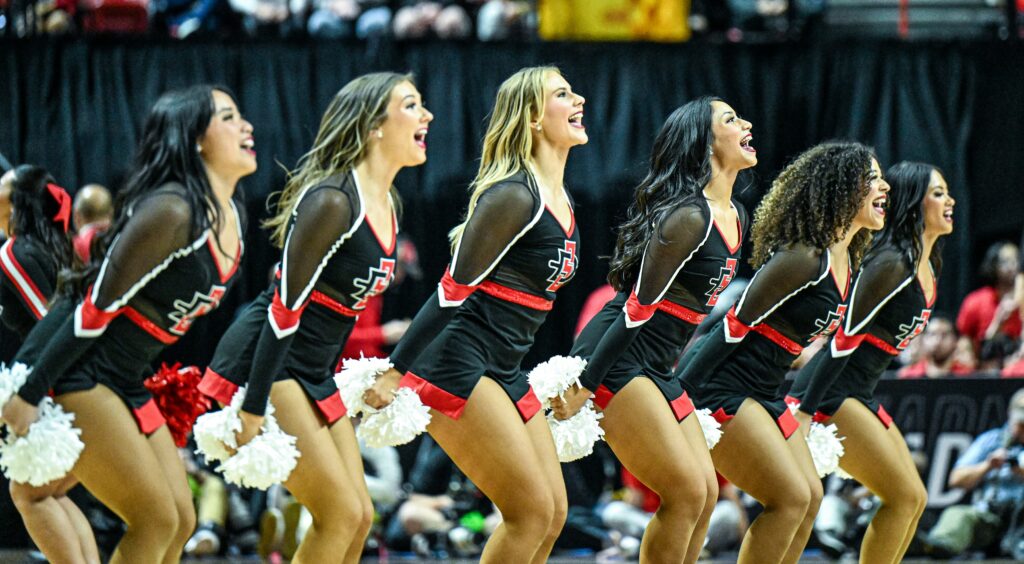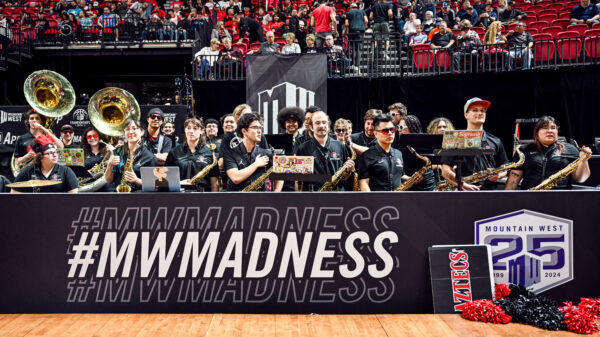Aztecs put on their Blazers to go dancing

SDSU's cheer leaders perform at the MW Championship. (Deanna Goldberg/EVT)

For the fourth straight season, the San Diego State Aztecs are dancing in the March Madness tournament.
On Selection Sunday, they received a five-seed in the east region and will face the 12-seed UAB Blazers in Spokane, Washington, at 10:45 am Pacific time. UAB received the AAC’s automatic bid after defeating Temple in the AAC championship game.
General Observations
UAB is not a tall team. Three players in the rotation are 6-foot-9. Everyone else is 6-foot-4 or shorter. They play an average tempo on each side of the floor. They are top-25 in offensive rebounding and drawing fouls but ranked below average in most facets of the game.
How to defend UAB
The Blazers offense is predicated on two basic principles. PG Eric Gaines uses his quickness to penetrate into the paint and draw a second defender. From there, Gaines can decide to shoot or pass. He is great at passing to the open man. If he makes the shot, then great. If he misses, he might have drawn a foul. If he misses and there is no foul, he likely drew a second defender to contest the shot, meaning someone like Lendenborg is free to snag the offensive rebound and get a putback.
UAB has the 59th-best offense, according to KenPom, despite ranking 206th in effective field goal percentage. For comparison, the Aztecs rank 62nd and 219th, respectively. The Blazers have such a good offense because they get a lot of putbacks and draw a lot of fouls.
Boxing out and not allowing offensive rebounds is the number 1 key to slowing down UAB. They thrive off the chaos after an offensive rebound. pic.twitter.com/F47PQUKb8G
— Aztec Breakdown (@aztecbreakdown) March 19, 2024
Slowing UAB down first means not allowing dribble penetration. Expect the Aztecs to switch ball screens to deny ball handlers into the paint. That will continue until UAB shows they can take advantage of the matchups they get.
It also means boxing out. The Aztecs are a slightly above-average defensive-rebounding team on the season, but they will need to lock in on that end if they want to slow down the Blazers.
The other key factor will be limiting fouls, which will also be accomplished by limiting penetration into the paint. Any time the Aztecs force a jump shot without fouling is a win defensively. Some will go in, but the goal is to keep their shots away from the basket and collect the rebounds when they miss.
How to attack UAB
UAB has two styles of defense. The first is a man-to-man defense with a lot of switching. They will switch 1-4, and sometimes even 4-5. If they are not switching, they will likely hedge the screen. In the clip below, they switch the first handoff, hedge the pick-and-roll, and then drop the second handoff. They vary that based on location and personnel.
Some of UAB’s man to man defense, including switches, hedges, and drops. pic.twitter.com/JwyGibpCC6
— Aztec Breakdown (@aztecbreakdown) March 19, 2024
The complexity of their coverage sometimes leads to confusion. In the next clip, two defenders get confused about who is supposed to guard the perimeter player. It results in an open shot. The shot was missed, but it was a defensive failure regardless. Blatant misses like this happen a few times each game and could be the difference if the Aztecs can take advantage.
UAB miscommunicates their switches quite often for people who are used to watching the Aztecs. Taking advantage of that might be key. pic.twitter.com/KAKIypE1j0
— Aztec Breakdown (@aztecbreakdown) March 20, 2024
The second, and likely the one the Aztecs will see the most, is a pressure 1-3-1 zone. The basic concepts are the same as the 1-3-1 zones Aztec fans are used to, but they extend the zone further out and are much more aggressive with their traps.
The UAB zone at its best. They don’t make it easy, but if the Aztecs can best the trap the rim will be wide open. Quick ball movement and cuts are key. pic.twitter.com/TTkvCz8av2
— Aztec Breakdown (@aztecbreakdown) March 19, 2024
There are two main attributes a team needs to beat a zone defense. They are quick ball movement and three-point shooting. The Aztecs have not been able to do either consistently this season and have struggled against zone defenses.
The Aztecs will try a couple of things to beat that zone defense. The first is getting the ball into the middle of the zone. Usually, the player playing the center position will be placed on the free throw line in a 1-3-1 zone. UAB’s zone is so aggressive that the center often ends up with the ball at the top of the key. That can leave the free throw line open, which is great for Jaedon LeDee. He can catch the ball in a great spot against a broken defense. USF took advantage by getting an open corner three in the clip below.
UAB plays an aggressive, trapping 1-3-1 zone coverage often. pic.twitter.com/GfIXNcLEjU
— Aztec Breakdown (@aztecbreakdown) March 19, 2024
The key for SDSU wings will be to cut from the corner towards the hoop rather than spot up. Imagine the clip above, but with LeDee passing to Parrish, who is cutting to the rim and dunking rather than catching behind the arc. If LeDee catches the ball at the free throw line against a stretched-out defense like that, it should be automatic points.
The set play the Aztecs will run will involve Gortat screens. The ball will get passed to the weak side and then lobbed back to Lamont Butler. On the catch, Butler needs to attack right away. Elijah Saunders or Jay Pal will screen the player at the top of the key, preventing that rotation. LeDee will duck in against the low defender, preventing that rotation, and Lamont should get an easy layup.
Aztecs preferred set play to attack a 1-3-1 zone pic.twitter.com/cEo9PAxmqv
— Aztec Breakdown (@aztecbreakdown) March 19, 2024
The key difference will be that the wing defender will be more aggressive in trying to stop Butler. In the clip above, the Spartan wing just watched and let Butler run by. It will be imperative for Butler to make the right read, and decide if he can get by before the rotation gets there or not. If not, he needs to pass to the wing, who will hopefully also be cutting to the basket. Aggression and finishing at the rim should be major points of emphasis against this defense that is stretched too thin.
Plays to watch for
UCLA Screen
A UCLA screen is a back screen set for the point guard after passing the ball to the wing. It is a pet action for UAB, who will use it to open up halves, out of timeouts, etc. It gets their guards running downhill at the rim, and against defenses that communicate poorly, will often result in a layup.
The key for the Aztecs will be to have the big man, usually LeDee, drop into the paint until the guards can recover. That will take away the layup, and the Blazers do not have much shooting to burn the Aztecs for dropping back.
UAB executing a UCLA cut. pic.twitter.com/CcnUhiJngp
— Aztec Breakdown (@aztecbreakdown) March 19, 2024
Horns Screen
A horns screen is two screens set on opposite sides of the ball handler at the top of the key. It can confuse because the defensive big men do not know their responsibility on the screen until it gets utilized. Expect the Aztecs to switch on these screens to try and prevent the ball handler from getting to the rim.
UAB running a horns screen. pic.twitter.com/btNrzenQaV
— Aztec Breakdown (@aztecbreakdown) March 20, 2024
Key Players
Yaxel Lendenborg, No. 3, 13.9 points, 10.7 rebounds, 2.1 assists
Lendenborg is a matchup problem for the Aztecs. At 6-foot-9, he has the perimeter game of a slashing wing player but is also a terror on the boards. Fans will be eagerly anticipating the matchup between LeDee and Lendenborg, but it will probably be Pal and Saunders matched up against Lendenborg. Keeping him off the offensive boards will be paramount to an Aztec victory.
Lendenborg is an x-factor unto himself with his energy and rebounding ability. pic.twitter.com/pn5znUHeB9
— Aztec Breakdown (@aztecbreakdown) March 19, 2024
Eric Gaines, No.4, 12.2 points, 3.9 rebounds, 5.5 assists
Gaines has not been the most efficient scorer this season. He is largely held back by his 27.5% mark from behind the arc. What he excels at is using his speed to get into the middle of the defense to cause chaos. The Aztecs can sometimes struggle with quick guards; just look at what New Mexico’s Jaelen House did. The penetration forces a defensive big man to rotate and contest a shot, leaving guys like Lendenborg and Davies to collect offensive rebounds and easy putbacks. Preventing Gaines from getting into the paint will be a major focus defensively.
Javian Davis, No. 0, 9 points, 5.7 rebounds, 1.1 assists
Davis will be the primary matchup for Jaedon LeDee. Davies is not particularly efficient at scoring the ball, but he is good at drawing contact on his shots. If he baits LeDee into a couple of quick ones, it could spell trouble. On the flip side, the Blazers do not have much big depth behind Lendenborg and Davies. If LeDee can draw a few early fouls, it will help him dominate inside.
X-Factor
Defensive rebounding. It has been mentioned already, but offensive rebounding and putbacks are a key part of the offense for UAB. Preventing those second chances by securing the rebound will be crucial to keep the Blazers’ score low.
Native San Diegan living in Montana. Big time Aztec Basketball fan. Creator of Aztec Breakdown. Hoping to help people enjoy basketball more by increasing their understanding of it.